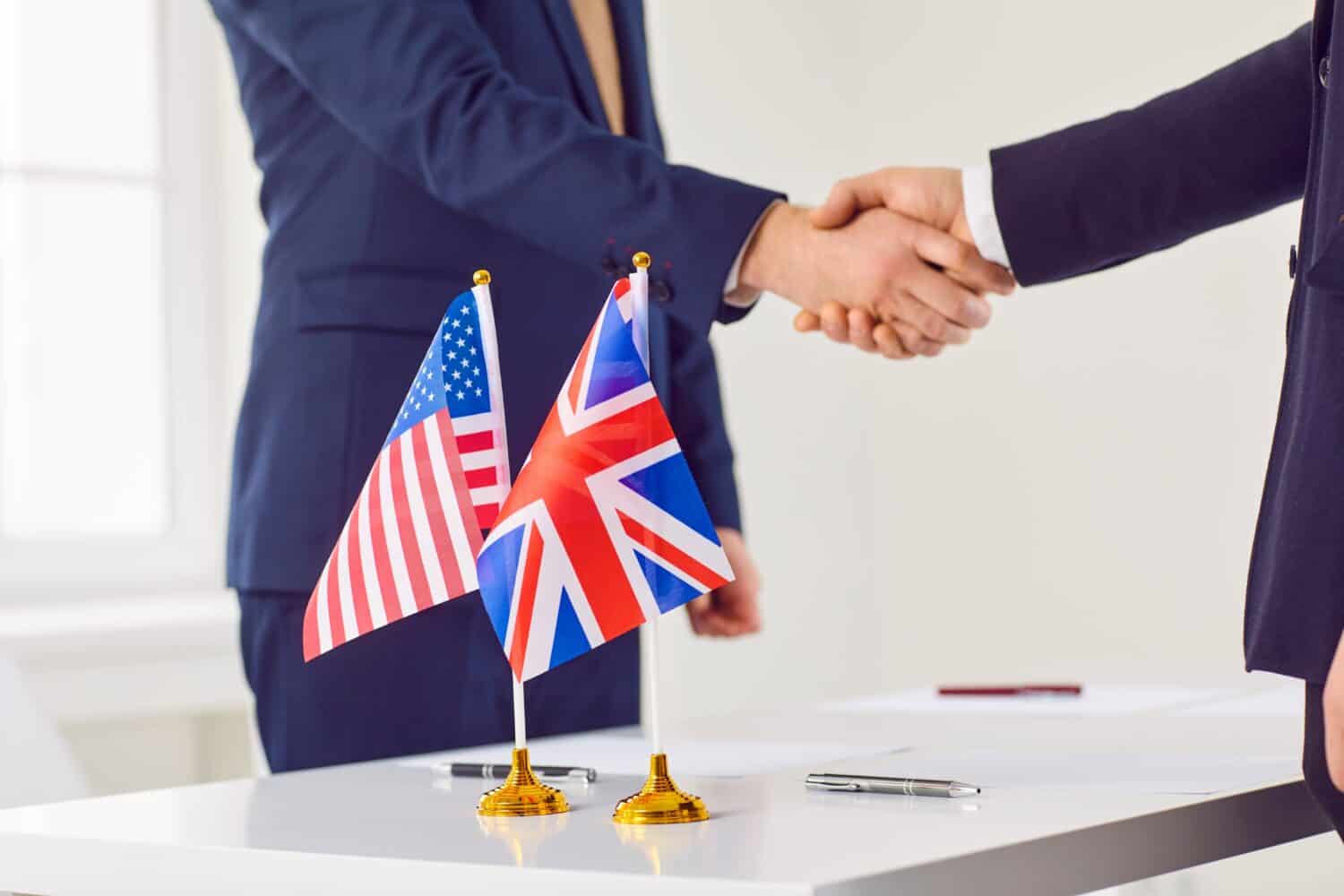
Since declaring independence in 1776, the United States has fought in at least 12 major wars and scores of smaller conflicts. Amazingly, today, America has close alliances with some of its former worst enemies. Why is it that the countries America destroys seem so willing to let bygones be bygones—even after the ultimate extreme of atomic warfare? This is the question we’ll explore by looking at some of the most successful examples of America’s swords-to-plowshares relationships, as well as some notable exceptions.
Rationale and Methodology

In a world rife with multi-generational conflicts, understanding how the United States has reconciled with its enemies can suggest ways other international conflicts might be solved. It may also have applications to other kinds of conflicts at the sub-national level, including corporate and even individual rivalries. Finally, it can help us in the aftermath of current and future conflicts to support generous policies toward defeated rivals, understanding that this is an investment with a major long-term payoff.
We’ll examine 12 major conflicts the country has been involved in since independence and consider the factors contributing to the USA’s current relationship with its former enemies. Analysis is provided by 24/7 Wall St.’s resident geopolitical specialist.
America’s Wars

The United States has been at war for much of its history. Three of the main reasons for American wars are:
- Independence – firmly establishing an independent country and its freedom to trade on the seas without harassment. We include in this category the Civil War, as it was a challenge the nation overcame to continue existing in the form established by its Founders.
- Colonization – conquering and settling new territory with American citizens. The United States had a preference for colonizing areas with little indigenous population, such as the northern half of Mexico. Rather than retaining the heavily-populated Philippines as a permanent part of the country, the United States granted it independence.
- Defense – countering foreign threats to maintain a favorable world order for the U.S. and its allies. Although many might dispute the legitimacy of specific conflicts for U.S. defense needs, the country’s modern conflicts have been for the broad purpose of “defense” rather than expanding the territory directly under American control.
Neocolonialism?

Some analysts point out that while powerful countries usually do not directly control and colonize smaller ones, their economic and diplomatic power is such that it creates a “neocolonial” dependency relationship. From that perspective, some of America’s recent wars could be analyzed as “colonial” ventures intended to keep a flow of raw materials, such as oil, continuing to power Western industries. A neocolonial power might interfere covertly in the internal affairs of other countries to keep friendly governments in power. This critique might account for weak pro-American governments that have existed temporarily in former enemy countries like Afghanistan. Still, neocolonialism may not be the best explanation of how the United States has maintained long-lasting friendships with great powers like the UK, France, Germany, and Japan. It is important to acknowledge and consider this perspective, but it is outside the scope of this article to do so in more detail.
1. The American Revolution

- Purpose: Independence
- War Dates: 1775-1783
- Opponent(s): British Empire
- Key Issues: Taxation without the consent of the people, lack of civil rights, monopolistic control of foreign trade, denial of access for settlers to new territories.
- Outcome: British defeat, American independence.
After the American Revolution

The U.S. and the British Empire remained enemies in the decades following the revolution. The British hoped the American experiment would fail and they could reassert authority—something the Americans feared might happen if they were not vigilant. Britain continued to treat Americans as inferiors and disrespect their rights as residents of a fully independent country. And the Americans looked uneasily to the north to Canada, which remained under British control, as a long-term security threat.
2. The War of 1812

- Purpose: Independence (rights to navigate and trade freely on the high seas).
- War Dates: 1812-1815
- Opponent(s): British Empire
- Key Issues: British interference with American trade, kidnapping of American sailors for service in the Royal Navy, and American desire to expand into Canada.
- Outcome: A draw. Britain agreed to leave U.S. ships and trade alone; both sides returned occupied territories and went back to prewar borders.
After the War of 1812

In the 1840s, the U.S. and Britain very nearly went to war a third time over the Oregon Country, a vast territory including Oregon, Washington, and British Columbia. In fact, James K. Polk was elected President on the slogan, “Fifty-Four Forty or Fight!”—an assertion that the U.S. would take control of the whole disputed territory up to latitude 54° 40′, which would have connected the continental United States to Alaska and left Canada without a Pacific coast. Finding California and other southwestern territory more attractive, Polk agreed to negotiate a settlement with Britain and launch the Mexican War instead.
In the following years, shared language and culture, profitable trade, and a common interest in excluding other European powers from the Americas brought the U.S. and Britain into alignment. Fighting common enemies in both world wars and the Cold War cemented the “special relationship” they enjoy today that goes even deeper than their shared commitments to the NATO alliance.
3. The Indian Wars

- Purpose: Colonization
- War Dates: 1776-1890
- Opponent(s): Native American Nations and coalitions.
- Key Issues: Control of land; conversion of hunting grounds in forests and plains to agriculture; seizure of mineral-rich areas considered sacred to indigenous people; unfair and broken treaties; atrocities committed on both sides.
- Outcome: U.S. victory. The Indian wars ended with the Wounded Knee Massacre in 1890. Native Americans were relegated to semi-autonomous reservations.
After the Indian Wars

Defeated Native Americans were placed on semi-autonomous reservations and forced into cultural assimilation over many decades. Today, Native Americans are an integral part of the society and culture of the United States, but many indigenous communities suffer from social issues related to cultural destruction. This creates feelings of resentment toward the American government.
4. The Mexican War

- Purpose: Colonization
- War Dates: 1846-1848
- Opponent(s): Mexico
- Key Issues: Annexation of Texas and establishment of a final border with Mexico. American desire to expand across the continent as part of its “Manifest Destiny.”
- Outcome: Mexican defeat. The U.S. annexed all the territory that today makes up all or part of 7 southwestern states.
After the Mexican War

During World War I, Germany plotted to get Mexico into war with the United States, promising to help it recover lost territories. This was never a realistic possibility, as Mexico lacked the military-industrial power to take on a major power like the United States.
Today, the U.S. and Mexico do not have a formal military alliance but cooperate on issues like drug trafficking, immigration, and trade. Together with Canada, the U.S. and Mexico have had a free trade agreement since 1994 that has benefited all three countries.
5. The Civil War

- Purpose: Independence (continuing existence as a united country)
- War Dates: 1861-1865
- Opponent(s): The Confederate States of America
- Key Issues: Slavery, states’ rights, cultural differences
- Outcome: The Confederate states were defeated and forced to reintegrate into the United States.
After the Civil War

The Union planned to industrialize the South and build infrastructure after the war, but those plans were frustrated by the economic depression of 1873-1879. As a result, the region remained poor and undeveloped for many decades. The Civil Rights Movement of the 1960s created resentment in many Southern states as the Federal government intervened to overturn segregationist policies.
Now, 159 years after the Civil War, the South has been successfully reassimilated into the country. Differences remain, with some areas lagging behind national averages in education, development, and standards of living. But by and large, the South is a highly patriotic region of America that shows no inclination to make another attempt at secession.
6. The Spanish-American War

- Purpose: Colonization
- War Dates: 1898-1902
- Opponent(s): Spain
- Key Issues: U.S. support for Cuban independence, desire for territorial expansion, explosion of a U.S. battleship in Havana Harbor.
- Outcome: After an American victory, Cuba gained independence and the U.S. took as colonies the Philippines, Guam, and Puerto Rico.
After the Spanish-American War

Spain continued to decline as a colonial power until it went through a civil war in the 1930s. Fascist dictator Francisco Franco came to power but kept the country neutral during World War II. As a result, he was able to stay in power until his death in 1975. After that, Spain began a years-long journey of democratization and warming relationships with the rest of Europe and the United States. Spain joined NATO in 1982, officially becoming one of the United States’ closest allies.
7. World War I

- Purpose: Defense
- Dates: 1917-1918
- Opponent(s): Germany, Austria-Hungary, Bulgaria, the Ottoman Empire
- Key Issues: A power struggle for control of Central and Eastern Europe; a system of secret alliances that entangled countries in the war; German attacks on American shipping; German efforts to provoke Mexico to attack the U.S.
- Outcome: Victory for the U.S. and its allies. The defeated countries did not immediately become U.S. allies, but most of the territories they once ruled had become part of NATO by the 21st century.
After World War I

The multinational empires of Europe were split up at the end of World War I along ethnic lines, but imperfectly so, especially in the Balkans. A prime example is the creation of Yugoslavia, which combined Macedonians, Serbs, Croats, Bosniaks, Montenegrans, Slovenians, Kosovars, and others into a single uneasily united country. German populations remained in border areas like the Sudentenland in Czechoslovakia, creating a pretext for a later German invasion. These types of issues, along with the harsh conditions imposed on the defeated countries at the war’s end, worsened by the stock market crash of 1929 and the resulting depression, were among the direct causes of World War II.
8. World War II

- Purpose: Defense
- War Dates: 1941-1945
- Opponent(s): Germany, Italy, Japan, Hungary, Romania, Bulgaria, Slovakia, Croatia
- Key Issues: Aggressive expansionism of fascist powers, driven by economic depression, racism, and nationalism.
- Outcome: Complete defeat for Axis powers, concluded by dropping atomic bombs on Japan. Postwar occupation rebuilt German and Japanese society along Western lines. All of the defeated countries are today allies of the United States.
After World War II

After the defeat of the Axis, the rise of the communist Soviet Union and its allies was a powerful external threat that forced the weakened countries of Europe to band together for self-defense. Through the Marshall Plan, the United States invested billions into rebuilding the western half of the continent and organized the NATO alliance as part of a dual-pronged strategy to prevent the spread of communism. This strategy was successful, so much so that the USSR and its allies collapsed. Today, the U.S. is allied through NATO not only with its former World War foes, but many of its Cold War ones in Eastern Europe as well. Japan is not in NATO but has a bilateral defense treaty with the United States.
9. The Korean War

- Purpose: Defense
- War Dates: 1950-1953
- Opponent(s): North Korea, China
- Key Issues: Unprovoked communist North Korean attack on South Korea, later supported with Chinese military intervention.
- Outcome: A draw. South Korea retained its independence along largely the same borders as before the war. The United States permanently stationed troops in the country to deter future North Korean attacks.
After the Korean War

Devastated by the war but still independent, North Korea went on to remain in a permanently militarily mobilized state, using the threat of Western invasion as a justification for the harsh sacrifices it demanded from its people. It has devoted tremendous resources to the development of nuclear weapons and ICBMs capable of reaching the North American mainland in the event of conflict.
10. The Vietnam war

- Purpose: Defense
- War Dates: 1955-1973
- Opponent(s): North Vietnam
- Key Issues: Communist North Vietnamese subversion of South Vietnam and neighboring Laos and Cambodia. U.S. desire to prevent a “domino” effect of regional countries falling to communism.
- Outcome: U.S. defeat. South Vietnam, Laos, and Cambodia all fell under communist rule after the U.S. withdrawal in 1973. The U.S. maintained a trade embargo on Vietnam for 30 years.
After the Vietnam War

Following the war, the United States imposed a 30-year economic embargo on Vietnam. In the 1970s, Vietnam invaded Cambodia to remove the more radically communist Khmer Rouge from power and fought a brief, sharp border war with China. With China emerging as a common foe, the U.S. began selling military equipment to Vietnam in 2007. The two countries also have a burgeoning trade relationship.
11. The Persian Gulf Wars

- Purpose: Defense
- War Dates: 1990-1991, 2003-2011
- Opponent(s): Iraq
- Key Issues: Iraqi invasion of Kuwait, threat to Saudi oil fields, suspicion of weapons of mass destruction.
- Outcome: The Iraqi invasion of Kuwait was reversed in the first war. The second war removed dictator Saddam Hussein and unsuccessfully searched for evidence of the development of weapons of mass destruction.
After the Persian Gulf Wars

Removing the Iraqi dictator and his ruling party left Iraq without a functional government and with powerful secessionist movements by the Kurds in the north and Shiites in the south. Iranian influence in the country grew immensely. Iraq remains unstable and has porous borders that allow the movement of terrorists and arms from Iran to Syria, Lebanon, and Palestine. The U.S. provides military aid and training to Iraq. However, Iraq asked the U.S. to remove its troops in 2020 over a drone strike that killed important Iranian and Iraqi officials. Thus, the current status of the U.S.-Iraqi relationship is complicated at best.
12. The War in Afghanistan

- Purpose: Defense
- War Dates: 2001-2021
- Opponent(s): Taliban rulers of Afghanistan
- Key Issues: Taliban support for Osama bin Laden and 9-11 plotters, state sponsorship of terrorism.
- Outcome: U.S. defeat. Although the Taliban were driven from power, they regained control 20 years later when the U.S. withdrew its troops in 2021.
After the War in Afghanistan

The United States Institute of Peace reports the U.S. spent $2.3 trillion on the war, lost the lives of about 7,500 American and allied troops and contractors and over 160,000 Afghanis. Afghanistan continues to suffer from civil rights abuses, terrorism, poverty, and instability today. It’s safe to say Afghanistan’s current government and the U.S. consider one another archenemies.
Reasons for American Successes

Looking back at the 12 major conflicts the United States has been involved in since independence, these are some of the reasons the U.S. has been able to befriend former enemies. (Note that we are not endorsing all of these but merely noting them factually as contributing factors from various eras of U.S. history).
- The original issues that caused conflict, such as border disputes, were solved.
- Conquered areas were colonized with a U.S. population that remained loyal.
- Some enemies lacked options because the United States could invade again in the event of a conflict.
- Some defeated countries were occupied, their governments changed, and their societies restructured according to Western values.
- The United States invested heavily in some countries to rebuild their economies and integrate them into world trade systems.
- The U.S. and its former opponents had mutual interests in areas like trade or defense against a powerful common enemy.
Although Vietnam is not an American ally, some of the factors are in place for it to become one in the future. Most of the outstanding issues between the two countries are settled and they have economic and geostrategic interests that are bringing them together.
Reasons for American Failures

Some of America’s more recent conflicts continue to this day. North Korea and Afghanistan remain implacable U.S. enemies, while Iraq is deeply destabilized and attempting to hold itself together in the face of internal divisions and regional power struggles. These are some of the reasons that contributed to these failures:
- The United States withdrew before the reasons for the conflicts were resolved or total victory was attained (and which may not have been attainable).
- American occupations in Iraq and Afghanistan did not attempt and could not have achieved a deep cultural transformation that might have integrated them thoroughly into Western institutions.
- With North Korea and Afghanistan, there are no common enemies or economic and trade interests that could unite the U.S. and these rivals.
In Iraq, some issues will likely keep the country in the American orbit in the decades to come. The oil trade, Euphrates River water sharing with U.S. ally Turkey, and threats from neighboring Iran are just a few.
Applications in the World, Business, and Home

Although most of us don’t have the authority to determine foreign policy, we do vote and have the ability to influence public policy. And in fact, these same lessons can be useful in business and our personal relationships:
- It’s important to resolve outstanding issues completely, not leaving unfinished business that will fuel future conflict.
- Generosity toward those we’ve defeated is not simply an act of altruism. It can pay off tremendously for ourselves in a future mutually beneficial relationship.
- Friendship can be built on the basis of finding areas of common benefits as well working together to overcome common challenges.
Obviously, all this is far easier said than done. But the American experience with its opponents illustrates that the effort can be worth it in the long run.
It’s Your Money, Your Future—Own It (sponsor)
Retirement can be daunting, but it doesn’t need to be.
Imagine having an expert in your corner to help you with your financial goals. Someone to help you determine if you’re ahead, behind, or right on track. With SmartAsset, that’s not just a dream—it’s reality. This free tool connects you with pre-screened financial advisors who work in your best interests. It’s quick, it’s easy, so take the leap today and start planning smarter!
Don’t waste another minute; get started right here and help your retirement dreams become a retirement reality.
Read more:
Politics, alliances, allies, international relations, United States, wars, world war
Thank you for reading! Have some feedback for us?
Contact the 24/7 Wall St. editorial team.
Latest from 24/7

Discover Our Top AI Stocks
Our expert who first called NVIDIA in 2009 is predicting 2025 will see a historic AI breakthrough.
You can follow him investing $500,000 of his own money on our top AI stocks for free.